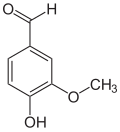The vanilloids are compounds which possess a vanillyl group. They include vanillyl alcohol, vanillin, vanillic acid, acetovanillon, vanillylmandelic acid, homovanillic acid, capsaicin, etc. Isomers are the isovanilloids.






vanillyl alcohol vanillin vanillic acid acetovanillon Vanillylamine Capsaicin
A number of vanilloids, most notably capsaicin, bind to the transient receptor potential vanilloid type 1 (TRPV1) receptor, an ion channel which naturally responds to noxious stimuli such as high temperatures and acidic pH. This action is responsible for the burning sensation experienced after eating spicy peppers. Endogenously generated chemicals that trigger the TRPV1 channel of the vanilloids class are referred to as endovanilloids including anandamide, 20-hydroxyeicosatetraenoic acid (20-HETE), N-arachidonoyl dopamine (NADA) and N-oleoyl-dopamine (CID 5282106 from PubChem).
Fatty acid amide hydrolase (FAAH), is a crucial enzyme for endovanilloid, and the N-acylethanolamines (NAEs), catabolism at TRPV1, and other cannabinoid receptors.
Outside the food industry vanilloids such as nonivamide are used commercially in pepper spray formulations.
Other vanilloids which act at TRPV1 include resiniferatoxin and olvanil.
References
- Pingle, SC; Matta, JA; Ahern, GP (2007). Capsaicin receptor: TRPV1 a promiscuous TRP channel. Handbook of Experimental Pharmacology. Vol. 179. pp. 155–171. doi:10.1007/978-3-540-34891-7_9. ISBN 978-3-540-34889-4. PMID 17217056.
- Van Der Stelt M, Di Marzo V (2004). "Endovanilloids. Putative endogenous ligands of transient receptor potential vanilloid 1 channels". Eur J Biochem. 271 (10): 1827–34. doi:10.1111/j.1432-1033.2004.04081.x. PMID 15128293.
- Hamers A, Primus CP, Whitear C, Kumar NA, Masucci M, Montalvo Moreira SA; et al. (2022). "20-hydroxyeicosatetraenoic acid (20-HETE) is a pivotal endogenous ligand for TRPV1-mediated neurogenic inflammation in the skin". Br J Pharmacol. 179 (7): 1450–1469. doi:10.1111/bph.15726. PMID 34755897. S2CID 243939400.
{{cite journal}}: CS1 maint: multiple names: authors list (link) - De Petrocellis L, Chu CJ, Moriello AS, Kellner JC, Walker JM, Di Marzo V (2004). "Actions of two naturally occurring saturated N-acyldopamines on transient receptor potential vanilloid 1 (TRPV1) channels". Br J Pharmacol. 143 (2): 251–6. doi:10.1038/sj.bjp.0705924. PMC 1575334. PMID 15289293.
{{cite journal}}: CS1 maint: multiple names: authors list (link) - Silva, M.; Martins, D.; Charrua, A.; Piscitelli, F.; Tavares, I.; Morgado, C.; Di Marzo, V. (2016-08-01). "Endovanilloid control of pain modulation by the rostroventromedial medulla in an animal model of diabetic neuropathy". Neuropharmacology. 107: 49–57. doi:10.1016/j.neuropharm.2016.03.007. ISSN 0028-3908. PMID 26965218.
- Carlson, Neil R.; Birkett, Melissa A. (2017). Physiology of Behavior (12 ed.). Pearson. p. 212. ISBN 9780134320823.
Literature
- Lee, Jeewoo; Uk Kang, Sang; Yeon Kim, Su; Eun Kim, Sung; Joon Jo, Yeong; Kim, Sunghoon (2001). "Vanilloid and Isovanilloid Analogues as Inhibitors of Methionyl-tRNA and Isoleucyl-tRNA Synthetases" (PDF). Bioorganic & Medicinal Chemistry Letters. 11 (8): 965–968. doi:10.1016/S0960-894X(01)00096-8. PMID 11327601.
